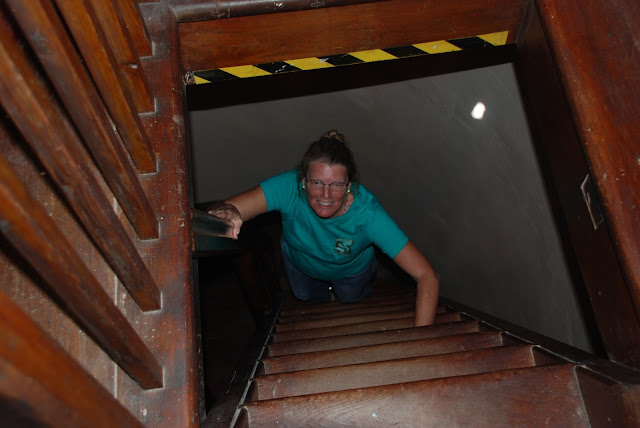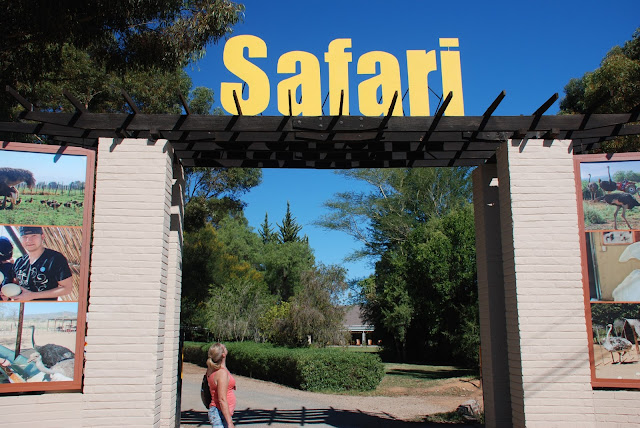Heading to Cape Agulhas!
These are our NEW homes for the next 25 Days!
Orientation with our new RVs.
All are 6 speed manual transmissions. No automatics available!
Cleaned up and ready to head out.
In SA you drive on the left with the steering on the right side?!?!?!?!
They love their round-a-bouts too!!
We are No. 3
Heading East towards Cape Agulhas!
Couldn't resist taking a picture of this old VW!
I'd guess late 59 to early 60's vintage.
Cape Agulhas, "Cape of the Needles" is a rocky headland in Western Cape, South Africa.
It is the geographic southern tip of the African continent and the beginning of the dividing line between the Atlantic and Indian Oceans according to the International Hydrographic Organization.Historically, the cape has been known to sailors as a major hazard on the traditional clipper route. It is sometimes regarded as one of the great capes. It was most commonly known in English as Cape L'Agulhas until the 20th century. The town of L'Agulhas is located near to the cape.
Cape Agulhas is located in the Overberg region, 170 kilometres (105 mi) southeast of Cape Town. The cape was named by Portuguese navigators, who called it Cabo das Agulhas—Portuguese for "Cape of Needles"—after noticing that around the year 1500 the direction of magnetic north (and therefore the compass needle) coincided with true north in the region.
South of Cape Agulhas the warm Agulhas Current that flows south along the east coast of Africa retroflects back into the Indian Ocean. While retroflecting, it pinches off large ocean eddies (Agulhas rings) that drift into the South Atlantic Ocean and take enormous amounts of heat and salt into the neighboring ocean. This mechanism constitutes one of the key elements in the global conveyor belt circulation of heat and salt.
Unlike its better-known relative, the Cape of Good Hope, Cape Agulhas is relatively unspectacular, consisting of a gradually curving coastline with a rocky beach. A survey marker indicates the location of the cape, which would otherwise be difficult to identify. The waters of the Agulhas Bank off the coast are quite shallow and are renowned as one of the best fishing grounds in South Africa.
The rocks that form Cape Agulhas belong to the Table Mountain Group, often loosely termed the Table Mountain sandstone. They are closely linked to the geological formations that are exposed in the spectacular cliffs of Table Mountain, Cape Point and the Cape of Good Hope.

Cape Agulhas Lighthouse!
Never thought Joan would climb the old wooded steps and ladders to the top
BUT she did - Hooray!!
What views!
Tide Pools
When the tide comes in, it refills these pools with seawater
which are used for swimming during low tide!

Heading down!?!

Standing in the warm Indian Ocean
A sponge washed up on shore
The Cape with its ROUGH surf & currents!
Reflecting on our day during a social!
Safisa was a native African who traveled with us as a mechanic.
Amarula is a cream liqueur from South Africa. It is made with sugar, cream and the fruit of the African marula tree (Sclerocarya birrea) which is also locally called the Elephant tree or the Marriage Tree. It has an alcohol content of 17% by volume. It has had some success at international spirit ratings competitions, winning a gold medal at the 2006 San Francisco World Spirits Competition.
This is good!!
The South African Wines were very good as well!
A little white wine, a little red wine & a little Amarula!!
I'm Happy!!
Visiting the Tide Pools!
A Quick Stop at Kapula Candles

And
Back on The Road Again!
Never Thought of Mountain Driving in Africa
But
Visiting the Ostrich Farm
Ostrich Tenderloin - Yum Yum!
Ostrich egg shells are REALLY thick and Strong!!
At 5.9 inches (approx.), ostrich eggs are the largest of any living bird, which doesn't come as a surprise, considering ostrich itself is the largest living species of bird in the world. A hen - female ostrich - can lay 40-100 eggs per year, which roughly amounts to one egg every second day from the mid-March till the mid-August. (In favorable conditions, the female can remain productive for 25-35 years.)
Joan was the first to volunteer sitting on the ostrich.
Why the bag over its head???
Hold still!!
Success!
How do you get off?
Carefully!
Gee Norm - LOOSEN THE GRIP!!!
How about a ride on one?!?
Hold on TIGHT!
The Cango Caves are located in Precambrian limestones at the foothills of the Swartberg range near the town of Oudtshoorn, in the Western Cape Province of South Africa. The principal cave is one of the country's finest, best known, and most popular tourist caves, and attracts many visitors from overseas. Although the extensive system of tunnels and chambers go on for over four kilometres, only about a quarter of this is open to visitors, who may proceed into the cave only in groups supervised by a guide.
Cycling is really big around the Cape area.
The Tsitsikamma National Park is a protected area on the Garden Route, Western Cape and Eastern Cape, South Africa. It is a coastal reserve well known for its indigenous forests, dramatic coastline, and the Otter Trail. On 6 March 2009 it was amalgamated with the Wilderness National Park and various other areas of land to form the Garden Route National Park.
The park covers an 80 kilometres (50 miles) long stretch of coastline. Nature's Valley is at the western end of the park, and the main accommodation is at Storms River Mouth. Near the park is the Bloukrans Bridge, the world's highest bungee jump at 216 metres (709 ft).
The word "Tsitsikamma" hails from the Khoekhoe language tse-tsesa, meaning "clear", and gami, meaning "water", probably referring to the clear water of the Tsitsikamma River. Other meanings are 'place of much water' and 'waters begin'.
This is one of our FAVORITE camping spots!!
We stayed here 2 nights!
The view is incredible right in front of our RVs!!!
As we watched the waves crashing into the rocks
We noticed a pod of dolphins playing!
A great Place to Absorb the Beauty and Sounds!
Lets Watch the Sunset
WOW!
Next morning we headed over to do an early morning hike!
This little critter was basking in the morning sun!
We started our hike here along the Garden Route of the coast!
This is what we saw!
Lots of currents and pounding waves!
Next Stop ADDO
Elephant Park!!


















































































































































No comments:
Post a Comment